Themed collection Stimulus-responsive polymers

Stimulus-responsive polymers
Peter J. Roth and Andrew B. Lowe introduce this themed issue for Polymer Chemistry on stimulus-responsive polymers.

Polym. Chem., 2017,8, 10-11
https://doi.org/10.1039/C6PY90169G
How to manipulate the upper critical solution temperature (UCST)?
In this mini-review, we discuss multi-stimuli-responsive polymers, which exhibit upper critical solution temperature (UCST) behavior mainly in aqueous solutions, and focus on examples where counter ions, electricity, light, or pH influence the thermoresponsiveness of these polymers.
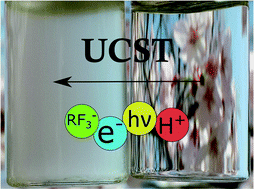
Polym. Chem., 2017,8, 220-232
https://doi.org/10.1039/C6PY01612J
RAFT polymerization to form stimuli-responsive polymers
Stimuli-responsive polymers respond to a variety of external stimuli, which include optical, electrical, thermal, mechanical, redox, pH, chemical, environmental and biological signals. This paper is concerned with the process of forming such polymers by RAFT polymerization.

Polym. Chem., 2017,8, 177-219
https://doi.org/10.1039/C6PY01849A
pH-Responsive polymers
This review summarizes pH-responsive monomers, polymers and their derivative nano- and micro-structures including micelles, cross-linked micelles, microgels and hydrogels.
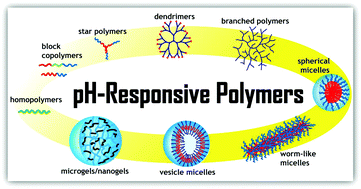
Polym. Chem., 2017,8, 144-176
https://doi.org/10.1039/C6PY01872F
Stimuli-responsive polymers and their applications
Responsive polymer-based materials are capable of altering their chemical and/or physical properties upon exposure to external stimuli. This review highlights their use for sensing and biosensing, drug delivery, and artificial muscles/actuators.
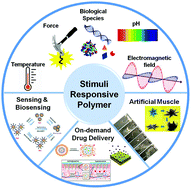
Polym. Chem., 2017,8, 127-143
https://doi.org/10.1039/C6PY01585A
Glutathione responsive polymers and their application in drug delivery systems
Materials which respond to biological cues are the subject of intense research interest due to their possible application in smart drug delivery vehicles.

Polym. Chem., 2017,8, 97-126
https://doi.org/10.1039/C6PY01365A
Field responsive materials: photo-, electro-, magnetic- and ultrasound-sensitive polymers
Recent advances in field-responsive polymers, which have emerged as highly promising materials for numerous applications, are highlighted.
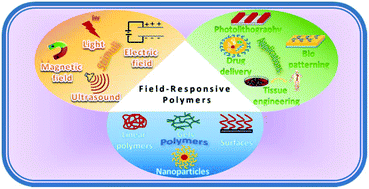
Polym. Chem., 2017,8, 74-96
https://doi.org/10.1039/C6PY01455K
Thermoresponsive poly(2-oxazoline)s, polypeptoids, and polypeptides
Recent advances in thermoresponsive poly(2-oxazoline)s, polypeptoids, and polypeptides, with a specific focus on structure–property relationships, self-assembly, and applications, are reviewed.
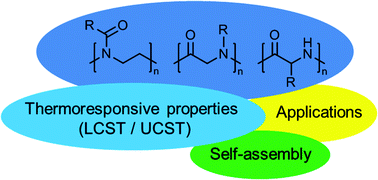
Polym. Chem., 2017,8, 24-40
https://doi.org/10.1039/C6PY01320A
Photo-responsive polymers: synthesis and applications
Photo-responsive polymers are able to change their structure, conformation and properties upon light irradiation.
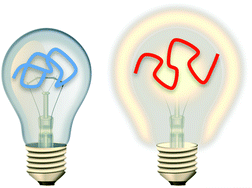
Polym. Chem., 2017,8, 52-73
https://doi.org/10.1039/C6PY01082B
CO2-Responsive polymer materials
This paper reviews the chemical fundamentals of CO2-responsive polymers as well as the latest reported “smart” material systems switched by CO2.
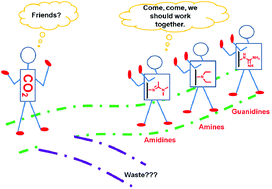
Polym. Chem., 2017,8, 12-23
https://doi.org/10.1039/C6PY01101B
Smart polymers in drug delivery: a biological perspective
Key to the widespread application of smart polymers in drug delivery is understanding the mechanistic interplay, as well as consequence, of the presence of these macromolecules within living systems.
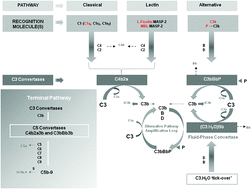
Polym. Chem., 2017,8, 41-51
https://doi.org/10.1039/C6PY00676K
Effect of the zwitterion structure on the thermo-responsive behaviour of poly(sulfobetaine methacrylates)
Modulating the thermo-responsive behaviour of poly(sulfobetaine methacrylates) whereby small structural changes cause big effects but show little logic.

Polym. Chem., 2017,8, 310-322
https://doi.org/10.1039/C6PY01220E
Self-healing of glucose-modified polyurethane networks facilitated by damage-induced primary amines
Mechanical damages are able to induce formation of reactive groups, which with a proper catalyst, will lead to self-healing.
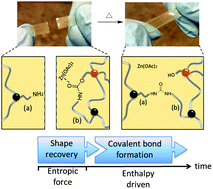
Polym. Chem., 2017,8, 303-309
https://doi.org/10.1039/C6PY01221C
Double-networks based on pH-responsive, amphiphilic “core-first” star first polymer conetworks prepared by sequential RAFT polymerization
Double-networks based on amphiphilic polymer conetworks synthesized using RAFT polymerization were prepared, exhibiting pH-responsiveness, nanophase separation and enhanced mechanical properties.
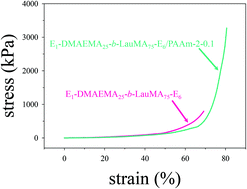
Polym. Chem., 2017,8, 245-259
https://doi.org/10.1039/C6PY01340F
Architectural evolution of phase domains in shape memory polyurethanes by dissipative particle dynamics simulations
The MDI phase in SMPUs develops a framework with netpoints evolving from spheres, to linked-spheres, linked-cylinders, and then to linked-bi-crossing-cylinders.

Polym. Chem., 2017,8, 260-271
https://doi.org/10.1039/C6PY01214K
The effects of the photo-induced proton generation on the assembly formation of dual-temperature and pH responsive block copolymers
The effects caused by photo-induced proton generation on the assembly formation of dual-temperature/pH-responsive block copolymers are investigated.
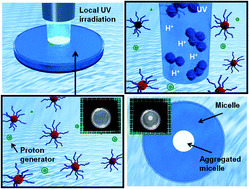
Polym. Chem., 2017,8, 295-302
https://doi.org/10.1039/C6PY01269H
Is biopolymer hair a multi-responsive smart material?
A twin-netpoint-switch structure model for animal hair has been proposed for interpreting different shape memory abilities when exposure on different external stimuli, where a twin-netpoint/single-switch structure is for the stimulus of water, heat and UV-light, and a single-netpoint/twin-switch structure is for the stimulus of redox agent.
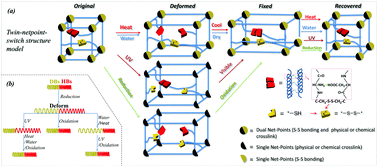
Polym. Chem., 2017,8, 283-294
https://doi.org/10.1039/C6PY01283C
Probing the causes of thermal hysteresis using tunable Nagg micelles with linear and brush-like thermoresponsive coronas
Self-assembled thermoresponsive polymers in aqueous solution have great potential as smart, switchable materials for use in biomedical applications.

Polym. Chem., 2017,8, 233-244
https://doi.org/10.1039/C6PY01191H
Stimulus-responsive non-ionic diblock copolymers: protonation of a tertiary amine end-group induces vesicle-to-worm or vesicle-to-sphere transitions
Morpholine-functionalised poly(glycerol monomethacrylate)-poly(2-hydroxypropyl methacrylate) diblock copolymer vesicles are transformed into worms or spheres on lowering the solution pH.
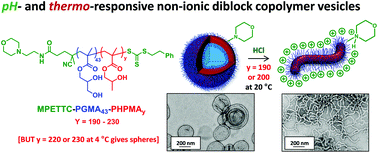
Polym. Chem., 2017,8, 272-282
https://doi.org/10.1039/C6PY01076H